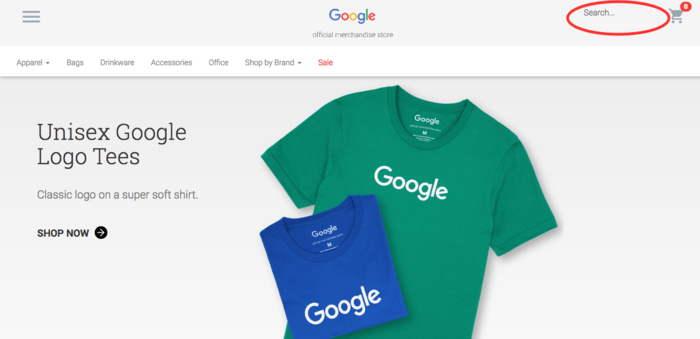Search data is a valuable source of information because your customers are literally typing out what they want from your site. Understanding what they’re searching for and how successful they are will give you insights into your customer’s demand, your inventory and your search algorithms. This tutorial will explain how to measure and analyze the performance of your site search in Google Analytics.
Sample Data
In the example video, we are using the GA demo account which is of a Google online property, Google Merchandise Store, that sells Google-branded merchandise. The website has a search functionality in the top right corner. As you can probably tell by the layout, the search isn’t a prominent feature of the site and it gets little use.

To get a good set of example data to look at, we’ll look at several months of data. If you want to follow along and have the data look the same, sign up for the demo account and in the date range in the reports select 09/01/2017 - 2/28/2018.
To look at your own search data, this guide helps you set up your site search with Google Analytics. Once tracking is in place, Google Analytics will start collecting data about your site search.
How to Measure and Analyze Performance of Your Site Search
Overview Report
The Overview report gives you just that - high level metrics about your search. Some of the more important ones are:
-
% Sessions with Search: How often search is used by site visitors
-
Results Pageviews / Search: How many pages of results a user views after executing a search. Ideally the result they want is in the first page or two of results
-
% Search Exits: The percent of searches where the user left without clicking through any result. This is analogous to a bounce rate
-
Average Search Depth: How many pageviews users had after executing a search
-
Time after Search: How much time users spend on the site after the search
Google Analytics provides more details on all the search metrics.
To view the metrics:
-
Navigate to the Behavior - Site Search - Overview report
-
At the top you can select the desired segments if you have any and the date range
-
The top line chart shows search usage by day
-
Next are summary statistics about the search. Again, you can see this site has minimal use of search - only 0.04% of sessions execute a search.
-
Lastly, at the bottom is a table with the search terms users typed in and their frequency. You can see that by far the most searched term is “gopher” (likely referring to this mascot)
Search Terms Report
Another very useful report is the Search Terms report. It provides many of the same metrics as the Overview report but at the search term level. To view the metrics simply navigate to the Behavior - Site Search - Search Terms report.
Search Pages Report
If you can access your search function from many pages, you may also want to see search metrics by page that originated the search. For this use the Search Pages report, which you can get to by navigating to Behavior - Site Search - Search Pages.
Usage Report
The Usage report gives you information about the overall session performance for users with search, not just stats on the search itself like the previous reports. For example, the metrics pages/session and average duration refer to the activity of the entire session that had a search - not just activity after the search.
To view the metrics:
-
Navigate to the Behavior - Site Search - Usage report
-
Scroll down to the bottom table. This aggregates performance data by “Site Search Status” - whether the session had a search or not.
-
To see data in the Conversions section of the table for your data, you need to have e-commerce tracking and/or goals set up in your Google Analytics account
-
To add specific search terms, click on Secondary Dimension and add “Search Term” under Behavior
Note that if in the same session a user searched for two different terms, that user’s session activity will be counted on both terms, so some duplication exists.
Conclusion
Use a combination of the reports to understand what users are searching for and whether they’re finding what they want. Execute the top search terms yourself on your site to see if you understand why performance is the way it is.
-
How many results come up?: Maybe you don’t have what the user is looking for and this user has unmet demand. Consider whether you want to add those products
-
Are the results relevant?: Maybe your search engine isn’t correctly interpreting the search terms. Consider improvements to your search engine
-
Does the result ranking make sense?: Maybe your search ranking isn’t providing optimal ranking and demands that users page through multiple pages of results to get to the desired result. Consider improvements to your results ranking algorithm
Search data is a valuable source of information because your customers are literally typing out what they want from your site. Understand what they’re searching for and how successful they are after the search will give you insights into your customer’s demand, your inventory, and your search algorithms.